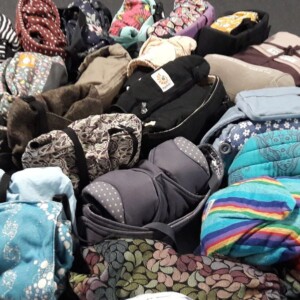Does my sling fit ok?
“Does my sling fit ok?” Everyday people ask whether their sling fits, or whether it looks ‘right’ or ‘safe’. The thing is nobody can tell from a photo whether you’re comfortable. It’s not always even possible to identify all safety issues.
There are lots of factors that go into deciding whether a sling is fitted well for you and your baby. This blog is designed to give you the tools you need to check that your sling is safe, fits your baby and is comfortable for you.
There are lots of techniques for checking whether your sling is suitable – T.I.C.K.S is widely known. Our simple carrying safety guide uses ABS to isolate three safety aspects involved in carrying.. This blog gives you the tools to understand how to monitor safety and to recognise how sling fit relates to safety.
Three steps to the right fit
If you’re using any sling or carrier there are 3 areas that you can check to see if your sling is fitted well. First, make sure the carry is safe, second, check whether it is supporting your child for great comfort, and good development, and lastly, you must check your own comfort.
- Safety
- Child’s development and comfort
- Carer’s (your) comfort
Safety first
The first and most important factor to consider with any carrier or sling use is safety. For carrying to be safe it must meet the ABS of safe carrying:
- Aware: You must remain attentive and responsive at all times.
- Breathing: You must ensure your child can breathe well at all times.
- Secure: You must ensure your sling or carrier are fitted to ensure your child cannot fall.
Aware
A sling or carrier can enable us to drink a cup of tea, or to venture off the path, however, we still need to remain attentive to our baby. It is really important that we stay aware of our child’s position, and remain attentive to their cues or changes in their condition., Our awareness is essential to ensure they remain safe the whole time they are in the sling. To monitor them effectively their position, and that of the sling or carrier must not impede our view, or other checking mechanism. For example, we must be able to easily check that a baby’s airways are supported and their face is uncovered.
Checks:
- Carer is attentive and responsive
- Baby’s position allows easy monitoring
- Carer can see their child’s face.
Breathing

Your baby needs to be supported in the carrier so that they can breathe well; their airway must be maintained, and good oxygen flow available. To maintain their airway, you need to ensure that their head and spine are supported so their chin does not drop onto their chest (check you can get a finger under their chin!) and so that they cannot slump down into the carrier, into a curled position. Check that your carrier feels snug, holds your baby in this position and does not slacken as you walk.
To avoid suffocation, ensure your baby’s face is uncovered, and positioned such that your body, clothing, and the sling or carrier do not cover their mouth or nose. Your child needs fresh air to circulate freely around their face at all times. This helps to ensure that their oxygen levels are maintained. This is best achieved in an upright position, with plenty of space around their face, no coverings, and nothing preventing them from lifting or turning their head.
Checks:
- Free air circulation
- Unobstructed face
- Chin off chest
- Upright carry
Secure
Your baby needs to be secure in the carrier and safe from falling out. You need to feel able to take your hands away, confident that your little one is securely held. Check all buckles are fastened and tightened. Ensure knots are tight. Regularly check your carrier for wear and tear to ensure tit doesn’t fail whilst you’re carrying your baby.
If a sling fits then when it is adjusted your baby should be held close to you. Their body should move with yours, and not shift, slide or swing as you turn. Similarly, if you place your arms over the carrier to hold your baby, when you let go their position should not change. In other words their weight should not pull away from you.
Checks:
- Close carry
- Hands on until secure
- Adjust with care
- Remove slack
- Minimise gaps
- Support under bum and behind bac
Safety checked
Does my sling fit? In summary, any sling or carrier in which you can fulfil the above criteria can be said to fit.* Whilst other aspects of fitting might make a sling more comfortable or longer lasting for some people, the most important aspect is always safety and ANY Carrying is good carrying.
*assuming there are no medical issues that impact safety. For more specific discussion of individual needs contact us or book a consultation for specialised, individual advice.
Baby's comfort and development
A sling that offers a good fit will support your baby’s body in an appropriate way for their age or developmental stage. The ages given here are averages, each child will have their own timeline for reaching milestones. Therefore, check that your baby meets the developmental criterion rather than relying on the estimated age. You can get personalised advice for individual circumstances, as well as help learning to do your own sling fit checks from us or your local sling consultant.
We check five areas when considering whether a carry is appropriate for your child’s developmental stage and provides optimal comfort.
Support the neck with material height

Firstly, your carrier needs to support the top of your baby’s back to a height appropriate to their development. This support helps maintain an open airway and keeps your baby secure in the carrier. At the minimum a sling needs to support up to the child’s armpits to reduce the risk of falls. The highest a carrier should come is to the bottom of a baby’s ears. When a sling snugly supports the natural curve of your baby’s spine, their head will rest on your chest/back. Therefore there is no need for support behind baby’s head, in fact, such head supports can restrict a baby’s movement. Consequently, head supports can increase risk of smothering or suffocation.
The most significant factor when working out how high up the back a sling needs to support is to consider how well a baby can support their own body.
For example, a newborn baby usually has little or no head control. in this case, a sling or carrier needs to snugly support them to the nape of their neck. This ensures that their head will come to rest securely on the chest of the adult carrying them, thus minimising risk of slumping.
On average, from around 4 months old, many babies have developed strong head control. As a result the sling now only needs to support up to the top of their shoulders. In contrast to a newborn they are better able to adjust their head and upper body, so they can manage with less support.
Once your child is walking then the sling needs to support to the armpits.
The carriers come to different heights for different ages. If your sling is safe and also meets all the criteria to fit for your baby’s age and developmental stage then the sling is fitting well!
Hands up
Many babies like to chew their hands! They also use their hands to explore the world – touching themselves, you and whatever else they can reach! For this reason most babies are more comfortable when their hands are up near their face and many become distressed when their hands are down and trapped.
Smooth down the spine
Your sling needs to be smooth along your baby’s spine – no knots or bumps or lumps! There are lots of sensitive pressure points along your baby’s back which can trigger back arching, fussing and crying. It will also make it harder for you to maintain the curved spine position, which can make it harder to avoid slumping in the carrier. Some of these pressure points are especially sensitive in reflux babies.
If your sling has a pocket over your baby be aware of what you put in it! to avoid causing your baby discomfort.
Tilted pelvis
The tilted pelvis also supports the physiologically normal position for your baby, and supports a position which is optimal for hip development. Tilting the pelvis looks like angling your baby’s crotch towards you so that their knees come up and their bottom drops down. This position is often referred to as the ‘M’ position where your baby’s knees are above their bottom. This helps maintain the natural curve of the spine, which in turn supports their head resting on your and maintaining an open airway.
In a sling this makes sure that your babies weight is supported on their bottom rather than their thighs or legs, which is often more comfortable for your baby.
In very young babies knees will be close together and very high compared to their bottom. As your baby grows their hips will open, knees will move apart and drop lower, creating a flatter shape.
Supportive seat from knee to knee
In babies who are not yet walking the sling will ideally support from knee to knee. This helps support the physiologically normal position of your baby. This position supports the natural curve of the spine, which in turn supports their head resting on you and maintaining an open airway.
You need to ensure that your baby can always bend their knee freely. Overextension, when a sling extends past their knees this can cause serious discomfort, as well as damage to developing joints. It is better for the sling to be too narrow over too wide. An older baby baby can widen their hips and hold the weight of their legs in a comfortable position, but they cannot narrow or bend them against the pressure of an oversized carrier.
Once your baby is walking, ensuring your sling is knee to knee can be less important unless you or your baby are uncomfortable. For comfort of both baby and adult we would suggest that the sling supported at least 2/3 of the thigh.

Knee to knee in a Boba 4GS
Carer's comfort
As with so many things in parenting, your comfort comes last when checking a sling! There are lots and lots of things which will contribute to your comfort, and all slings will fit people slightly differently. It would be impossible to list everything that can be tweaked!
However some common examples are
- Keep straps away from your neck to avoid the carrier pulling and digging in. Move them to the flat bony part of your shoulder
- Spread and smooth the sling across your back to avoid anything digging in
- Make sure buckles and knots are on comfortable places on your body, both when you’re standing and when you’re sitting if you’re moving positions
The perfect sling for carrying your baby is safe, appropriate for your baby’s age and stage and comfortable for you both to use! If you’d like some help finding the right sling for you and your baby, or help fitting a sling you already have why not get in touch?





Responses